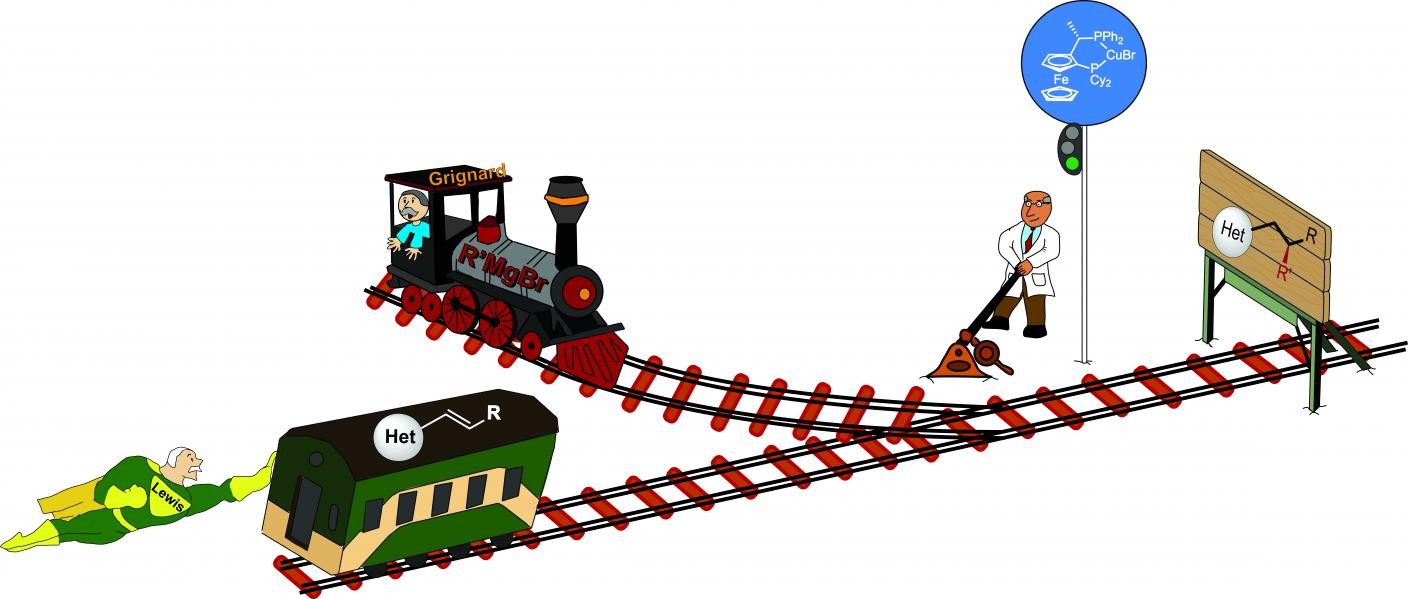Publicatie Science: ‘Coole’ combinatie verbindt koolstofatomen

Door twee bestaande technieken - elk een eeuw oud - uit de organische chemie te combineren bij lage temperatuur is het RUG-hoogleraar Syuzanna Harutyunyan en haar onderzoeksgroep gelukt om veel gemakkelijker en met meer precisie tal van organische verbindingen te maken. Het gaat om verbindingen die belangrijk zijn bij de ontwikkeling van nieuwe geneesmiddelen. Harutyunyan publiceert hierover in het gerenommeerde tijdschrift Science van 22 april.
Bijna 90 procent van alle actieve farmaceutische verbindingen bevat een of meer zogeheten ‘heterocyclische aromatische ringen’, structuren die atomen van ten minste twee verschillende elementen bevatten. De meeste ringen bevatten koolstof- en stikstofatomen. ‘Een cruciale stap in de vorming van moleculen met heterocyclische verbindingen is het koppelen van twee koolstofatomen’, legt Syuzanna Harutyunyan, adjunct-hoogleraar synthetische organische chemie, uit.
Juiste chirale versie
Maar het is extreem lastig om dit soort koolstof-koolstofbindingen te maken. Daar is vaak een tussenstap bij nodig, die het synthetische proces langer en daarmee minder efficiënt maakt. Bovendien zijn veel farmaceutisch interessante heterocyclische moleculen chiraal: ze bestaan in twee versies die elkaars spiegelbeeld zijn. Die twee versies vertonen vaak een verschillende biologische activiteit. ‘Dus we moeten ook nog de juiste chirale versie maken’, zegt Harutyunyan.
Efficiënt
En dat is precies wat Harutyunyan met haar team beschrijft in het Science-artikel: een efficiënte manier om koolstof-koolstofverbindingen te maken met een hoge chirale selectiviteit, die toepasbaar is op een groot aantal verschillende stikstofbevattende heterocyclische moleculen.
Grignard-reagens
Om deze doorbraak te bereiken greep Harutyunyan terug op methoden uit het begin van de twintigste eeuw. Zij gebruikte een Grignard-reagens dat is ontwikkeld door Victor Grignard, de winnaar van de eerste Nobelprijs voor chemie in 1912, en dat nog steeds een belangrijk hulpmiddel is bij het maken van koolstof-koolstofverbindingen.
Lewis-zuur
‘Maar onze heterocyclische verbindingen reageerden niet erg op het Grignardreagens.’ Daarom was de hulp nodig van een andere pionier in de organische chemie, een tijdgenoot van Grignard: Gilbert N. Lewis, de grondlegger van de ‘Lewis zuur/base theorie’. In deze theorie is een Lewis-zuur een chemische verbinding die een vrij elektronenpaar aantrekt. Door aan de elektronen te ‘trekken’ kan Lewis-zuur een molecuul reactiever maken. Harutyunyan gebruikte een zeer sterk Lewis-zuur om haar heterocyclische moleculen te activeren.
Lage temperatuur
Maar dat gaat in tegen het gezonde verstand, want het Grignard-reagens is een base, die dus zal reageren met het Lewis-zuur, wat beide neutraliseert. In eerder werk had Harutyunyan echter al laten zien dat dit niet gebeurt bij lage temperaturen. ‘Ik heb veel tijd gestoken in het bestuderen van de eigenschappen van beide reagentia en dat bracht mij ertoe ze bij -78 graden Celsius samen te brengen.’ Wanneer ze bij die lage temperatuur Grignard-reagens en Lewis-zuur combineert, wordt een koolstofatoom naast de heterocyclische ring geactiveerd zodat deze een koolstof-koolstof-verbinding aangaat. En om chirale selectiviteit te krijgen voegde Harutyunyan een koperbevattende katalysator toe.
Aanpassingen
Maar voor farmaceutische fabrieken is een temperatuur van -78 graden Celsius wat laag en bovendien vonden de eerste experimenten in het Groningse lab plaats in een op ether gebaseerd oplosmiddel. ‘Dat is te brandbaar voor de industrie’, zegt Harutyunyan. Door aanpassingen vindt het proces nu plaats bij -50 graden Celsius in het veel praktischer tolueen.
Belangstelling farmaceutische bedrijven
Farmaceutische bedrijven hebben al belangstelling getoond voor het werk van Harutyunyan. ‘Voor de ontwikkeling van geneesmiddelen is het belangrijk varianten te maken van een interessante verbinding. Ons proces maakt het eenvoudiger om dit te doen.’ Ondertussen bestudeert haar team hoe de combinatie van Lewis-zuur en Grignard-reagens precies werkt. ‘Ik ben zeer geïnteresseerd in het mechanisme van reacties. Alleen door te begrijpen hoe een proces werkt kun je het verbeteren.’ Harutyunyan hoopt de reactietemperatuur omhoog te brengen naar -40 of nog hoger. ‘Dat is een temperatuur waar de industrie mee uit de voeten kan. Maar mijn belangrijkste drijfveer is dat ik het proces wil begrijpen. Want er gebeurt iets heel bijzonders.’
Referentie: R.P. Jumde; F. Lanza; M.J. Veenstra; S.R. Harutyunyan : Catalytic asymmetric addition of Grignard reagents to alkenyl-substituted aromatic N-heterocycles. Science, 22 April 2016, DOI 10.1126/science.aaf1983
Lees ook: Bachelor-onderzoek levert Science publicatie op, over Marieke Veenstra, een van de vier auteurs.

Meer nieuws
-
02 december 2025
Student Menna Zahran wint Unilever Research Prize
-
27 november 2025
Vliegtuigen spotten met een radiotelescoop
